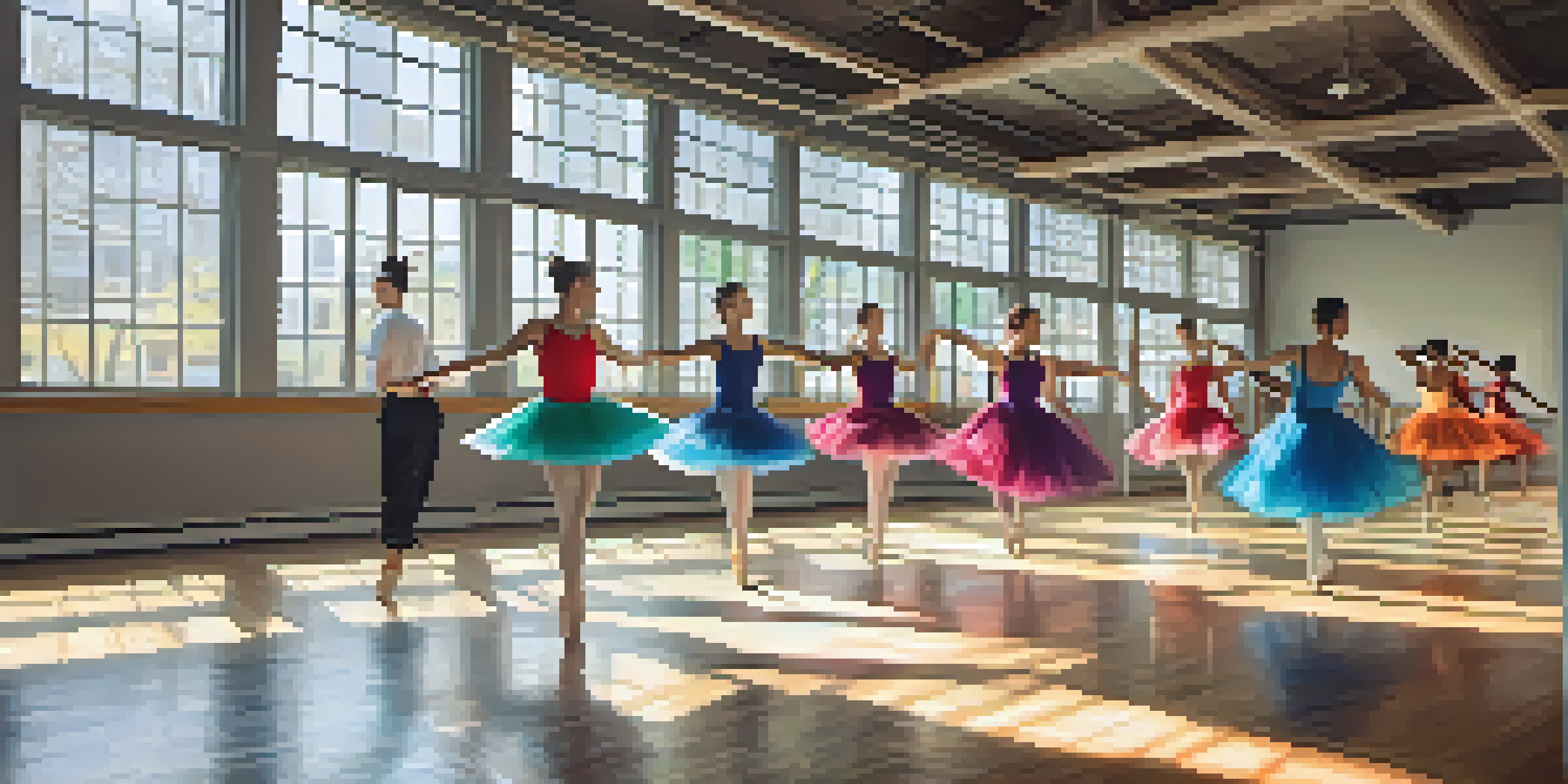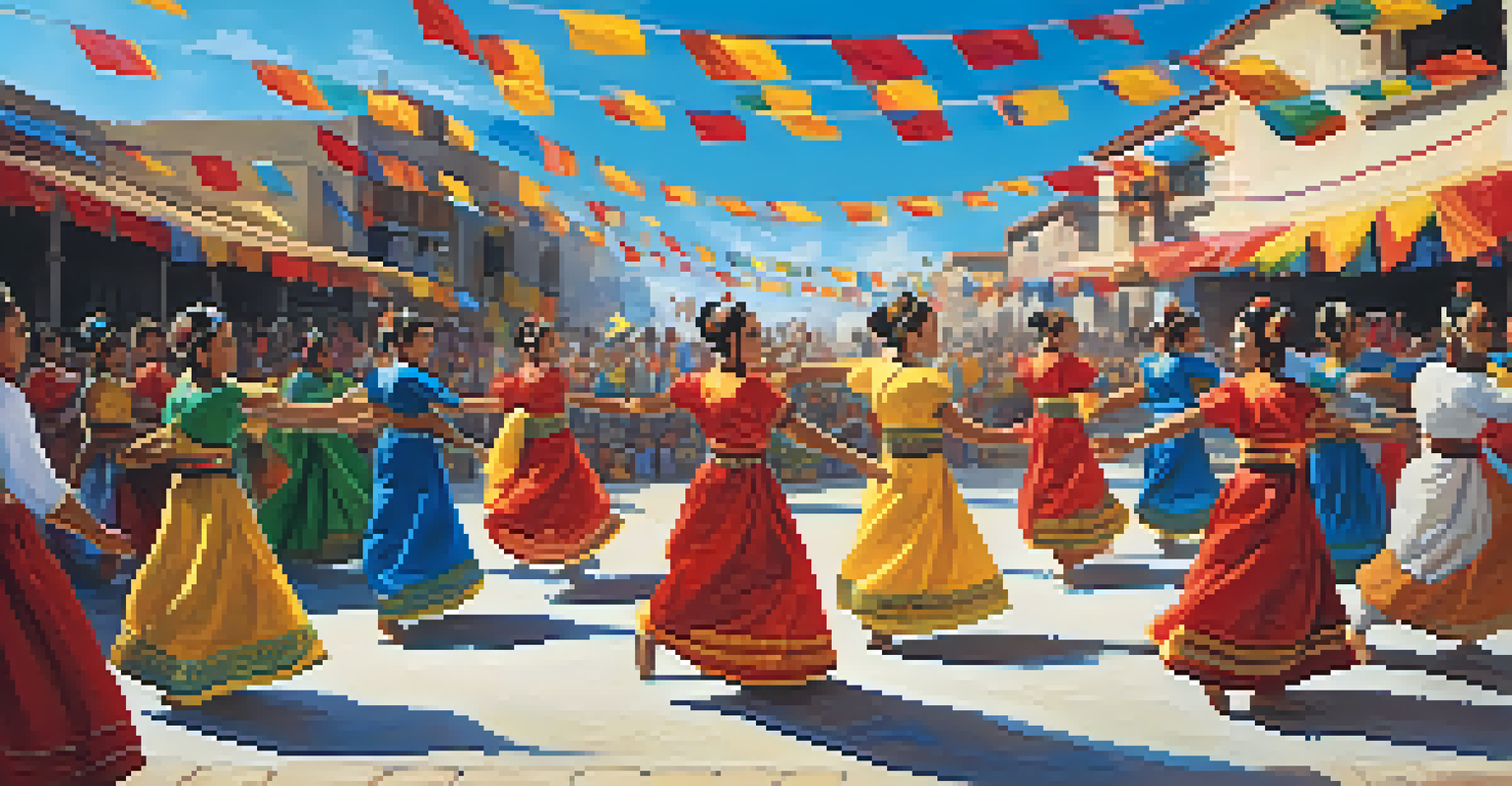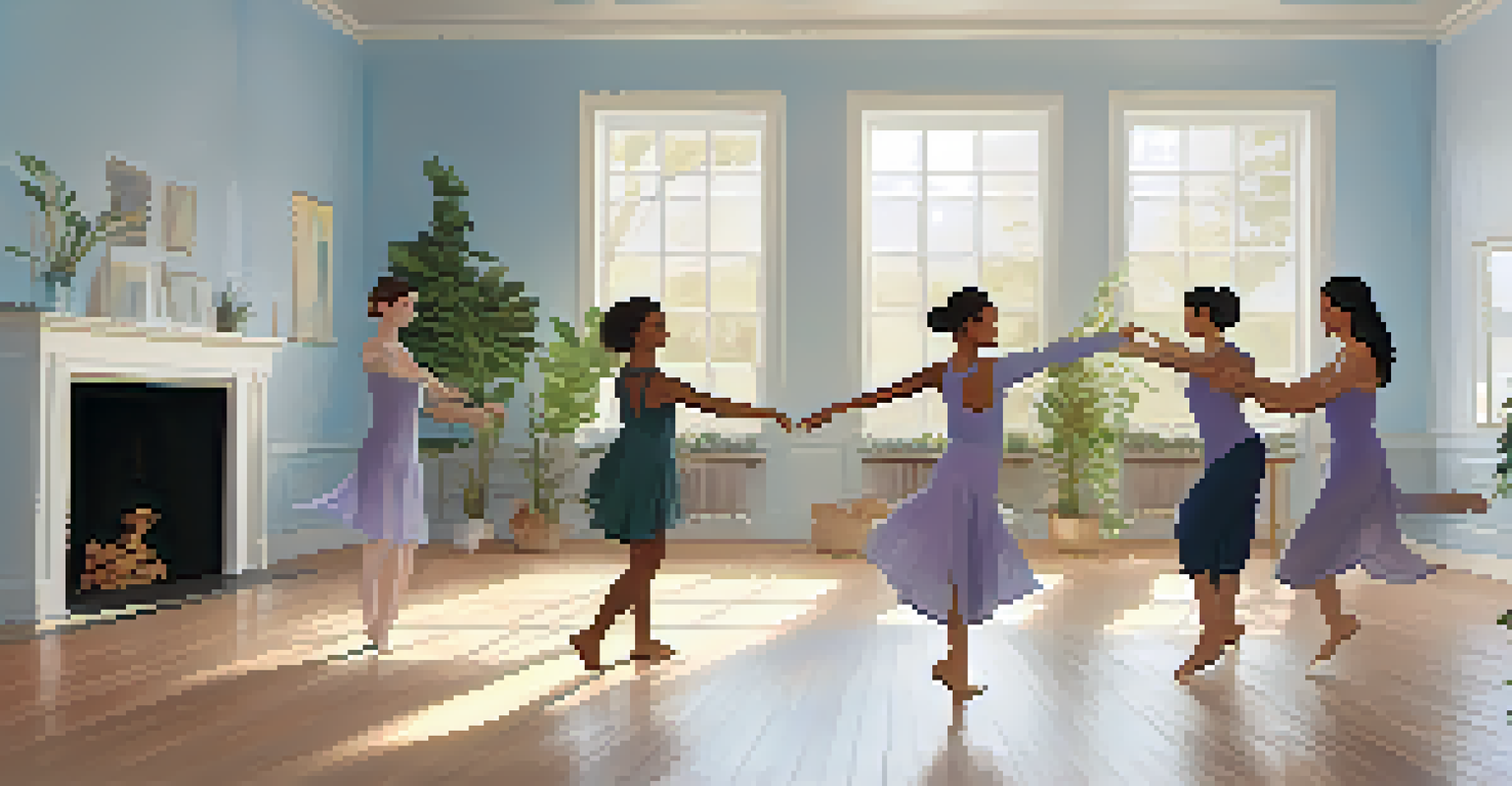Exploring Dance Styles That Enhance Empathy in Participants

Understanding Empathy Through Movement and Expression
Empathy is the ability to understand and share the feelings of others. In dance, this concept comes alive as movements evoke emotions and tell stories, engaging participants on a deeper level. By embodying different characters or emotions through dance, individuals can step outside their own experiences, fostering a connection with others.
Dance is the hidden language of the soul.
For instance, when dancers portray joy or sadness, they invite the audience to feel alongside them. This shared emotional experience can break down barriers, encouraging participants to open their hearts and minds. Through dance, individuals learn to appreciate diverse perspectives, which is a cornerstone of empathy.
Ultimately, dance provides a unique platform for exploring human emotions. It encourages participants to not only express their feelings but also to observe and respond to the emotions of others, creating a rich environment for empathy to flourish.
Ballet: The Art of Precision and Emotional Depth
Ballet, often seen as a rigid and precise art form, surprisingly offers profound opportunities for empathy. The structured movements and graceful expressions allow dancers to explore a wide range of emotions, from joy to despair. As they learn to convey these feelings through their choreography, they develop a deeper understanding of emotional nuance.

For example, a ballet performance that tells a story of loss can resonate with both dancers and audiences alike. The shared experience of watching and performing such narratives fosters empathy, as participants can relate to the universal themes of love, heartache, and hope. This connection is essential in building emotional intelligence.
Dance as a Path to Empathy
Engaging in various dance forms fosters emotional connections and understanding among participants.
Moreover, ballet often requires dancers to work in pairs or groups, promoting teamwork and communication. As they collaborate, dancers learn to read each other's body language and emotional cues, enhancing their ability to empathize with one another.
Hip-Hop: A Voice for Personal Stories and Community
Hip-hop dance is deeply rooted in expressing personal and community stories, making it a powerful vehicle for empathy. Through its energetic and expressive style, dancers share their individual experiences, often reflecting the challenges and triumphs of their lives. This authenticity resonates with audiences, fostering a sense of connection.
Empathy is about finding echoes of another person in yourself.
For instance, a hip-hop performance focused on social issues can evoke strong emotional responses, prompting viewers to reflect on their own experiences. When participants engage in this dance form, they not only express their own narratives but also gain insight into the lives of others, further enhancing their empathetic skills.
Additionally, hip-hop encourages collaboration and improvisation, where dancers must listen and respond to one another. This dynamic interaction cultivates a supportive environment, allowing participants to build trust and empathy as they navigate the complexities of group performance.
Contemporary Dance: Blending Styles for Emotional Exploration
Contemporary dance is a melting pot of various styles, offering a flexible framework for emotional expression. It encourages dancers to explore their individual feelings and experiences, often resulting in performances that resonate deeply with audiences. This freedom allows for a vast range of emotions to be conveyed, fostering empathy in both performers and viewers.
For example, a contemporary piece that explores themes of identity or belonging can prompt powerful reflections on personal experiences. As dancers connect with these themes, they invite the audience to do the same, creating a shared space for understanding and emotional growth. This interaction enhances the empathetic experience for everyone involved.
Collaboration Enhances Understanding
Dance encourages teamwork and communication, allowing individuals to read and respond to each other's emotions.
Furthermore, contemporary dance often incorporates elements of storytelling and improvisation. As dancers respond to each other's movements, they learn to attune themselves to the emotions and intentions of their peers, reinforcing the importance of empathy in their artistic expression.
Social Dance Forms: Building Bonds Through Shared Experience
Social dance forms, such as salsa, swing, and ballroom, are inherently collaborative and invite participants to connect with one another. These dances emphasize partnership and communication, making empathy a vital component of the experience. As dancers learn to lead and follow, they develop a keen awareness of their partner's feelings and responses.
For instance, in a salsa class, dancers must tune into their partner's movements and energy, creating a dialogue through dance. This interaction nurtures a sense of empathy, as participants become attuned to each other's emotions and physical cues. The joy of shared movement fosters a supportive environment that encourages emotional connection.
Moreover, the communal aspect of social dances often leads to friendships and a sense of belonging. This connection reinforces empathy, as individuals come together to celebrate their shared love for dance, creating a vibrant community built on understanding and support.
Dance Therapy: Healing Through Movement and Empathy
Dance therapy is a specialized form of therapy that uses movement to promote emotional healing and personal growth. In this setting, participants explore their feelings and experiences through dance, often leading to increased self-awareness and empathy. The therapeutic environment encourages individuals to connect with their emotions, fostering a deeper understanding of themselves and others.
For example, a group dance therapy session might focus on expressing grief. As participants share their stories through movement, they can witness and empathize with the experiences of others, creating a safe space for emotional exploration. This process not only enhances their own healing but also strengthens their ability to empathize with those around them.
Cultural Dance Fosters Diversity
Learning different cultural dances broadens perspectives and promotes appreciation for diversity and community.
Additionally, dance therapy often incorporates elements of improvisation and group dynamics, allowing participants to engage with one another in meaningful ways. This interaction promotes empathy as individuals learn to listen and respond to the feelings of their peers, reinforcing the therapeutic benefits of dance.
Cultural Dance Forms: Celebrating Diversity and Understanding
Cultural dance forms offer a unique opportunity to explore empathy through the lens of tradition and heritage. By engaging with dances from various cultures, participants gain insight into different ways of life, fostering a deeper understanding and appreciation for diversity. This exposure encourages empathy by broadening participants' perspectives and challenging their assumptions.
For instance, learning a traditional African dance can open doors to understanding the cultural significance behind the movements and rhythms. As dancers immerse themselves in the history and meaning of these practices, they develop a greater sense of empathy towards the people and communities they represent. This connection enriches their understanding of cultural nuances and values.

Moreover, cultural dance often involves community participation, promoting a sense of belonging and shared experience. As individuals come together to celebrate their heritage, they cultivate empathy through connection, learning to appreciate the beauty of diversity in their communities.
Conclusion: The Transformative Power of Dance in Enhancing Empathy
Dance is more than just a form of artistic expression; it is a powerful tool for enhancing empathy among participants. Whether through structured ballet or energetic hip-hop, each dance style offers unique opportunities for emotional exploration and connection. By engaging with these diverse forms of dance, individuals can develop a deeper understanding of themselves and others.
As participants navigate the complexities of movement and expression, they learn to appreciate different perspectives, fostering a culture of empathy. This transformative power of dance can lead to greater emotional intelligence, stronger relationships, and a more compassionate community.
Ultimately, exploring dance styles that enhance empathy not only enriches the individual experience but also contributes to a more empathetic society. By embracing the power of movement, we can cultivate understanding and connection in our lives and communities.